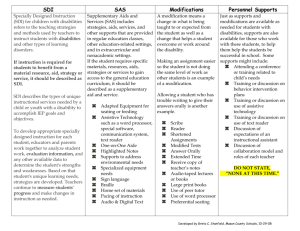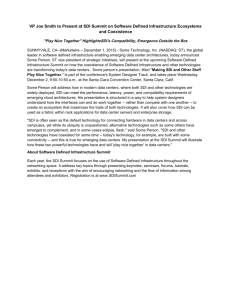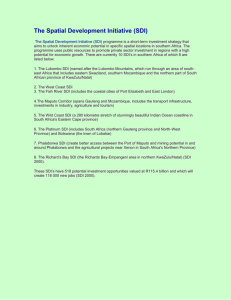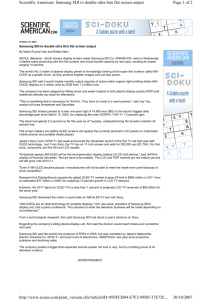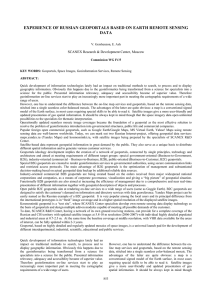Abstract
advertisement
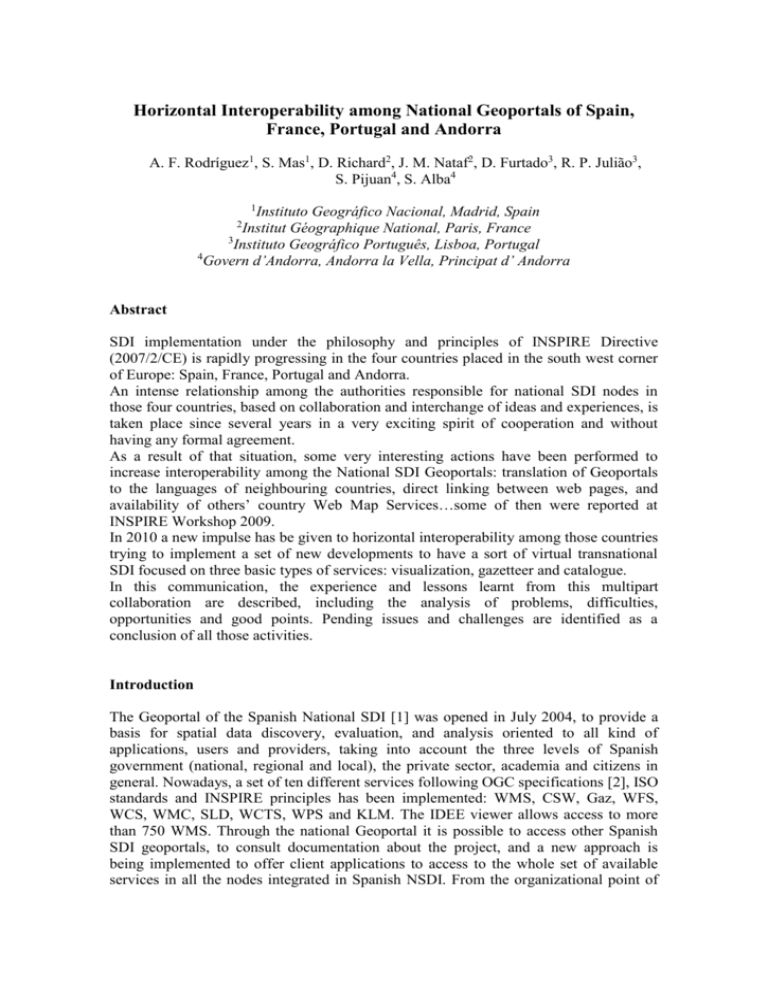
Horizontal Interoperability among National Geoportals of Spain, France, Portugal and Andorra A. F. Rodríguez1, S. Mas1, D. Richard2, J. M. Nataf2, D. Furtado3, R. P. Julião3, S. Pijuan4, S. Alba4 1 Instituto Geográfico Nacional, Madrid, Spain Institut Géographique National, Paris, France 3 Instituto Geográfico Português, Lisboa, Portugal 4 Govern d’Andorra, Andorra la Vella, Principat d’ Andorra 2 Abstract SDI implementation under the philosophy and principles of INSPIRE Directive (2007/2/CE) is rapidly progressing in the four countries placed in the south west corner of Europe: Spain, France, Portugal and Andorra. An intense relationship among the authorities responsible for national SDI nodes in those four countries, based on collaboration and interchange of ideas and experiences, is taken place since several years in a very exciting spirit of cooperation and without having any formal agreement. As a result of that situation, some very interesting actions have been performed to increase interoperability among the National SDI Geoportals: translation of Geoportals to the languages of neighbouring countries, direct linking between web pages, and availability of others’ country Web Map Services…some of then were reported at INSPIRE Workshop 2009. In 2010 a new impulse has be given to horizontal interoperability among those countries trying to implement a set of new developments to have a sort of virtual transnational SDI focused on three basic types of services: visualization, gazetteer and catalogue. In this communication, the experience and lessons learnt from this multipart collaboration are described, including the analysis of problems, difficulties, opportunities and good points. Pending issues and challenges are identified as a conclusion of all those activities. Introduction The Geoportal of the Spanish National SDI [1] was opened in July 2004, to provide a basis for spatial data discovery, evaluation, and analysis oriented to all kind of applications, users and providers, taking into account the three levels of Spanish government (national, regional and local), the private sector, academia and citizens in general. Nowadays, a set of ten different services following OGC specifications [2], ISO standards and INSPIRE principles has been implemented: WMS, CSW, Gaz, WFS, WCS, WMC, SLD, WCTS, WPS and KLM. The IDEE viewer allows access to more than 750 WMS. Through the national Geoportal it is possible to access other Spanish SDI geoportals, to consult documentation about the project, and a new approach is being implemented to offer client applications to access to the whole set of available services in all the nodes integrated in Spanish NSDI. From the organizational point of view, the Working Group for the IDEE (WG IDEE), open to all actors involved from public, private sector and academia, coordinates the project and defines technical recommendations based on consensus. IGN France opened in 2006 the first version of its Géoportail [3] with a 2D viewer that evolved in 2007 to a 3D viewer based on Virtual Globes technology enabling to freely navigate on orthophotos, maps and other reference datasets (cadastre, roads, hydrography...). Their extent covers France and its overseas territories. Setting up of these view services was with high availability (99.9%) and performance (up to 21,000 connections per second) objectives in mind. The technologies used for enabling such a quality of service level were WMS-C [4] from OSGeo. On the user's side, IGN France published in 2008, an Application Programming Interface (API) [5] to enable users to include a 2D cartographic viewer inside a web page. This API is based on OpenLayers [6] and is released under a BSD license. Accessing geoportal's datasets through this API implies getting a key allowing users to have free of charge up to 100,000 sessions per year, and then the price depends on the client's consumption. Some other key resources have been implemented in France as a Metadata Catalogue, operated by BGRM [7]; a National Gazetteer service based on OpenLS specifications. Portugal, one of the pioneer countries on SDI arena, launched the Portuguese NSDI (SNIG) in 1995. SNIG [8] enables users to identify, visualise and explore Geographic Information by using a geoportal and it is also an area of contact that allows organizing activities related to SDIs and INSPIRE implementation. The Portuguese geoportal has four main components: a metadata ccatalogue with more than 10,000 records about data and services, helped by a specific tool (ISO and OGC compliant) to support metadata production called MIG; a Viewer supporting WMS, WFS and WCS, allowing access to services provided by IGP and other Portuguese actors; an applications area, where users can search the catalogue applications that provide national thematic interactive maps, geoprocessing tools and free software applications; and the Geocommunity space, the meeting point for users and knowledge exchange, namely at Forum SNIG, as well as the entrance for some specific thematic networks, like RISE (Risk Network) or RGN (Geodetic Network) and SNIG Education. Through these four main components of SNIG, the user has public and free access data, applications and services about Portuguese spatial data. Portugal has transposed INSPIRE Directive by means of Decreto-Lei 180/2009 published on 2009-08-07. The NSDI of the Principality of Andorra opened its Geoportal [9] on September 2008 aiming to give the citizens the opportunity of viewing, accessing and using the geospatial information produced by the Government of Andorra. The project is conformant to ISO 19100 standards, OGC specifications and it follows the principles and criteria established in INSPIRE Directive for Europe. Therefore this initiative promotes the interchange of data and the interoperability of services with the neighbouring countries. Andorra is not a member state of UE, but collaborates in many practical aspects with UE and supports INSPIRE philosophy and principles. The geoportal is multilingual, having interfaces in Catalan, Spanish, French and English, it allows access to 16 WMSs and 4 CSWs, one for each language supported, and includes also a Street Map, a Directory of OGC services and a set of predefined maps. The viewer has some practical applications as walking routes computation, gazetteer and data download. The four countries are very actively involved in developing a set of web services to fulfil their users’ requirements and to try to implement the INSPIRE Directive philosophy and prescriptions, including the set of INSPIRE Implementing Rules. Horizontal Interoperability initial actions A first set of practical actions and activities has been developed until summer 2009 in order to increase practical interoperability among geoportals and services associated from the four countries. The main points achieved are the following: 1) Collaboration, covering all aspects related to the sharing of experiences, knowledge and good practices, at technical level as well as organizational level. There is an excellent collaborative atmosphere and there have been a lot of contacts and actions of consultancy and interchange of information. Two representations of Portuguese and Andorran SDIs have been integrated into the WG for the Spanish SDI (WG IDEE) and this WG is opened to all SDI actors from those countries. The Spanish annual SDI Workshop (JIDEE for Jornadas de la Infraestructura de Datos Espaciales de España) has been redefined as an Iberian Workshop on SDIs (JIIDE for Jornadas Ibéricas de Infraestructuras de Datos Espaciales) to cover Spanish, Portuguese and Andorran SDI communities. 2) Multinational transborder projects. IGN Spain and France has participate in SDIGER Project, an INSPIRE pilot Project developing an SDI to manage WFD information in a transnational river basin developed by a French-Spanish consortium [10]. There are three Portuguese-Spanish SDI projects developed under the umbrella of INTERREG III A program: - OTALEX [11], the Territorial Observatory of ALenteixo (Portugal) and Extremadura (Spain) defined as a transnational, multilingual SDI based on the collaboration of ten public bodies from Spain and Portugal. - SIGN II [12], an SDI project involving seven partners and covering the area of 56 municipalities from Galicia and the Northern part of Portugal. - Terra Douro [13], a transborder territorial observatory for the definition and evaluation of policies of sustainable development, defined as an SDI project, involving seven partners and covering the area of 4 NUTS III, Salamanca and Zamora in Spain, and Alto Trás-Os-Montes and Douro in Portugal. 3) Translation of Geoportals to the languages of the neighbouring countries. There are French, Portuguese and Catalan versions of Spanish IDEE Geoportal, a Spanish interface of the French Géoportail and French and Spanish translation of Andorran SDI Geoportal. A big effort of translation has been made and only a few combinations are missing. 4) A banner has been included in almost all cases, making easy the access from each geoportal to the neighbour SDI Geoportal. Cross links to publish URLs of web services are also included in each geoportal in most cases. 5) In Portuguese, French, Spanish and Andorran viewers they are direct links by default to Portuguese, Spanish and Andorran WMS in most cases of neighbour countries, to make easier its combined visualization with the national cartography. Some successful experiences where done using French API to visualize Spanish and French WMS-C services in ad-hoc viewer, based on Open Layers, to solve interoperability in the case of French GeoDRM approach. A more complete description of most of those activities can be found in [14] and [15]. New challenges After the success of the first phase of transborder collaboration integrated by the set of actions, measures and developments until summer 2009, it seems to be necessary to face new challenges regarding horizontal interoperability among the Geoportals in the region. The two main objectives of this new phase to increase and promote horizontal interoperability are: 1) To extend the multilingual measures and the crossed linking of resources (geoportals, services) to the four countries and all the possible combinations. Linguistic adaptability can be considered at three main levels: 2.1) Translation of static web pages. 2.2) Translation of web services client applications. 2.3) Translation of the information contained and published by the web services. Most of the effort done until now has been invested in 2.1), and some actions 2.2) has been also completed. The goal is to cover all 2.2) situations. It is necessary to take into account that any translation activity makes maintenance more complex and expensive. 2) To considered three very basic services (discovery, viewing and gazetteer services) for developing client applications able to invoke the web services from the four countries. Those two main objectives can be described in detail taking into account a list of more specific task to be completed: 1) To complete the translation and maintenance of the Geoportals static web pages to the languages of the other three countries in all the possible combinations (with the support of the other part body). 2) To finish also the translation of the viewers to the language of the other three countries in all cases. 3) To complete all the cross referencing of resources (banner of the rest of geoportals, links to web services of other three countries in services directories and web pages). 4) To implement an easy way, as URL inclusion by default, to invoke neighbour countries’ WMS and/or WMS-C services in each viewer application or in a new prototype developed ad hoc.. 5) To include in each Geoportal to a prototype of multiple gazetteer client application (application [16] developed by IGN Spain and University of Zaragoza, to be defined as free software) able to query simultaneously to several Gazetteer services conformant to an extensible set of Gazetteer standards (WFSG, WFS, WFS-MNE…). The point is allowing the users to consult simultaneously the Gaz. Service of the four countries and EuroGeonames gazetteer service [17]. 6) To include also in each Geoportal to a prototype of multiple catalogue client (Catalogue Connector [18] Free Software developed by the Supporting Centre [19] of the SDI of Cataluña) able to query simultaneously several Catalogue Services conformant to a extensible set of standards (CSW 2.0, ebRim, ISO 19115/19119 profiles…). The objective is allowing users to query simultaneously the catalog services of the four countries and INSPIRE catalogue [20]. 7) To continue promoting the interchange of ideas, knowledge, experiences and good practices, and the coordination and harmonization on SDI topics among the four countries. Portugal and Andorra SDI communities are invited to Spanish WG IDEE and cross-representatives are going to be interchanged with the more appropriate French working group dealing with INSPIRE implementation activities. Conclusions A set of actions has performed to make more interoperable Spanish, French, Portuguese and Andorran geoportals has performed some actions to be actually interoperable in the four first levels described, technical and organizational collaboration, Geoportal interoperability, transborder projects and clients interoperability. We have the intention of collaborate and get better results and closer collaboration during next years. There must be pointed out that all those actions and initiatives have been performed without signing a formal collaboration agreement and without any specific budget assigned to them, but in an excellent collaborative atmosphere of good spirit of cooperation and sharing expertise. It is very remarkable the approach of the SDI of Andorra, a country that being not a UE member state follows INSPIRE principles and regulations as a very interesting framework from technical and organizational points of view to implement a successful NSDI. Therefore, the result is a virtual SDI integrated by a set of integrated standard services supported by a transnational community covering four countries that share experiences, knowledge and information. This south west region of Europe can be considered a good test bed for study how INSPIRE principles can be put in practice regarding NSDI pragmatic interoperability, to test different solutions, identify problems and find further interoperability requirements. At the technical level, the experience has demonstrated that transborder actual interoperability is possible in the three basic services considered (discovery, visualization and gazetteer) with a limited effort. At the organisational level, is transnational interoperability can service policy strategies: free of WMS-C services, free of charge Andorra. remarkable that very interesting results regarding be achieved between different business models and charge up to a certain level of usage in France for for WMS, WMS-C services in Spain, Portugal and It is clear for us that a SDI must not be limited in any way to an isolated country, because it would imply a strong contradiction: to apply open system philosophy to digital resources, and not paying enough attention at the same time to the practical barriers precluding the effective exploitation of those services in an international arena. We think that more attention need to be paid to NSDI interoperability because horizontal interoperability can be play the role of the glue that create cohesion and makes possible the effective virtual Global SDI. References [1] http://www.idee.es [2] http://www.opengeospatial.org/standards [3] http://www.geoportail.fr [4] http://wiki.osgeo.org/wiki/WMS_Tile_Caching [5] http://api.ign.fr/geoportail [6] http://openlayers.org [7] http://www.brgm.fr [8] http://snig.igeo.pt [9] http://www.ideandorra.ad [10] http://sdiger.unizar.es [11] http://www.otalex.eu [12] http://www.proyectosign.org [13] http://www.sitcyl.jcyl.es/sitcyl/infodloc.sit [14] http://www.gsdi.org/gsdiconf/gsdi11/papers/pdf/120.pdf [15] http://www.gsdi.org/gsdiconf/gsdi11/papers/pdf/347.pdf [16] http://www.idee.es/IDEE-Gazetteer/index.html?locale=en [17] http://www.eurogeographics.org/eurogeonames [18] http://www.osor.eu/projects/catalogconnecto [19] http://www.geoportal-idec.net/geoportal/cat/inici.jsp [20] http://www.inspire-geoportal.eu
